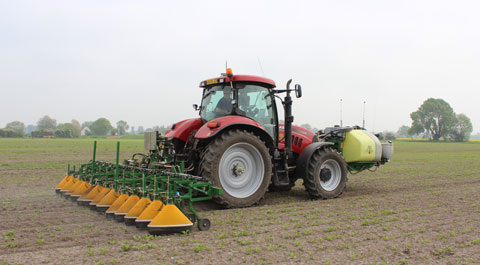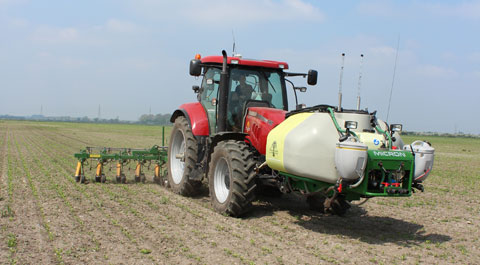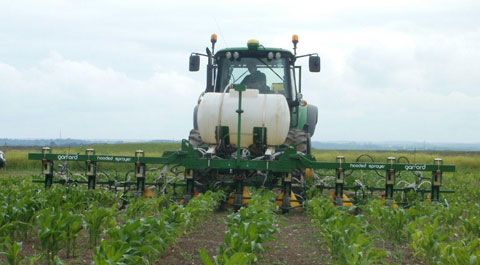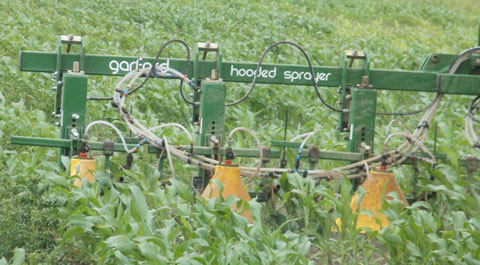High-tech band sprayers hit weeds hard

Most farmers wouldn’t dream of wafting a broad-spectrum weed killer anywhere near one of their carefully cared for crops.
But burgeoning weed problems and rocketing chemical bills have driven two leading arable growers to do just that.
Last year Cambridgeshire grower Edd Banks and Kent-based farm manger Andrew Pendry both invested in specialist band sprayers that can safely apply desiccants between rows of band-sown crops such as oilseed rape.
The hope was that troublesome, herbicide-resistant weeds could be removed quickly and cheaply without damaging the crop. After more than 12 months with experience with the machines, Power Farming got in touch to see how they were getting on.

After deciding Atlantis (mesosulfuron + iodosulfuron) was no longer worth applying on his herbicide-resistant blackgrass, Mr Banks decided to explore the band spraying option.
He approached Herefordshire precision sprayer maker Micron and asked it to build him a custom 6m hooded machine. This was adapted and fitted with a second spray line and split tank so that it could apply prescriptive chemicals or liquid fertiliser on crop rows at the same time.
To keep everything inline and stop the crop getting any unwanted treatments, Mr Banks used a 2cm accurate GPS signal from the farmer-owned RTK Farming network.
Last season the sprayer had two outings on a 100ha block of sugar beet and results were impressive. The inter-row between the crop was kept weed free, the crop escaped unscathed and there were low blackgrass populations up the crop rows, too.
This autumn the hooded element of the sprayer has performed equally well, but blackgrass control in the crop row has been disappointing. The fact the beet has been planted on heavier ground this year is partly to blame as are the soggy early-autumn planting conditions.
“We’ve now got a number of fields with 10cm stripes of blackgrass,” says Mr Banks. “The diquat has killed the weeds off perfectly between the rows and the prescriptive stuff has had no effect whatsoever.”
Even though the blackgrass remains along the rows of sugar beet plants, the sprayer has kept 60% of the field clean, he notes.

OSR opportunities
Although he’s managed to get two season’s-worth of spraying done on sugar beet, Mr Banks hasn’t yet managed to get going in oilseed rape – the autumn’s awful weather and the fact his Trimble control box decided to forget the sprayer existed, meant he had to resort to more traditional methods of crop husbandry.
But this autumn, he hopes to spray all oilseed rape with the band sprayer.
In preparation, he’s already adapted the farm’s TWB trailed subsoiler/drill and tweaked the usual drilling practices to make the job a bit easier. “You’ve got to start the process with accurate drilling. Even if you’re only a couple of centimetres out on each pass, you’ll be completely out of line after a few runs.”
Modifications started by giving the drill its own GPS steering system. But on the very first outing, it was clear this was a bad move.
“There is so much resistance with a subsoiler that the system couldn’t keep up,” he says. “As soon as it managed to pull the thing back on course it was out of line again.”
With the GPS unit promptly removed, Mr Banks fitted the subsoiler with pivoting legs. These let the legs do their own thing so the rig has got more chance of staying in line. He also fitted low disturbance feet to keep soil movement and blackgrass germination to a minimum.
Mr Bank’s first plan for the band sprayer in oilseed rape is at early post emergence. He hopes to apply a prescriptive herbicide on the row as well as band-applied diquat if there is still some blackgrass remaining after the stale seed-bed.
If the crop needs it, he might go in with some late-autumn liquid N on the row. But because N will be applied at drilling this might not be needed.
The Kerb (propyzamide) spray will be the last outing for band sprayer as long as the crop isn’t too big. And if the inter-row still has some blackgrass he might run the hoods through on a narrow setting to clean them up.
Output
Two of the main concerns with the band sprayer in the early days were output and durability. The narrow working width, relatively slow operating speeds and lightweight design threw up a few questions as to whether the veg-focussed machine would be up to the job.
Speed hasn’t proved to be a problem though. While using both on-row and inter-row spray lines Mr Banks has managed to get up to speeds of 9kph and when only using the hoods he can tank along at 11kph.
Width clearly limits the amount of ground that can be covered in a day, but the fact it’s doing a complete job and can carry out two applications at once more than makes up for it, he says.
It also seems to be tough enough for the job, with no serious breakdowns so far. “We might need some new hood skirts next year, but that’s about it.”
As a result of his success with the sprayer, Mr Banks has been asked to carry out contract spraying for a number of other beet growers. But because the drilling hadn’t been carried out accurately enough he couldn’t safely spray the crop. “It’s crucial that you accurately measure your drill and make sure your bouts match up perfectly, he says. “It also helps if the drill is the same width as the sprayer.”
Andrew Pendry opted for a similar setup to Mr Banks and purchased a 6m Garford hooded sprayer with two tanks and a separate spray line for prescriptive chemicals.
He also went a stage further and added a separate fertiliser applicator meaning three jobs could be carried out in one pass.
Mr Pendry chose to mount the boom on the front of the tractor with a liquid fertiliser tanks on the top and he hung the split chemical tank off the back. At 6m wide it matches up perfectly with his 6m Monosem drill.
Maize was the first test for the sprayer and he covered about 300ha with it last spring. At this time the driver drove the sprayer by eye, but Mr Pendry has now invested in RTK guidance from Burden Brother’s own dealership to improve accuracy. “We can now cover 60 acres (24ha) in a day instead of 40 acres (16ha) and the driver is less tired too.”
Switching to RTK also gave him the confidence to widen the hoods and spray glyphosate closer to the crop. This meant as much as 80% of the field was being sprayed with glyphosate while just 20% was left to the selective. But cutting it this fine did have its penalties. “The maize was only at two to three leaves when we sprayed it this year and there was just enough air movement to waft chemical on to a few plants.”
To get round this problem he plans to spray next year’s crop when it’s taller and there’s less air movement in the bottom of the canopy.

Oilseed rape
Last autumn was the first time the band sprayer ventured into an oilseed rape crop. This was planted in 460mm rows and was overrun with rape volunteers.
To make the sprayer line up with the crop, Mr Pendry adjusted the hood spacing and fitted extensions to up the width to 8m. That meant it was completely in sync with the rows planted by the farm’s 8m Sumo Versadrill.
On the first run the sprayer was taken down between the rows and it managed to remove almost all of the weeds and volunteers in the inter-row. The only problem was that there was still a high population of volunteers along the crop row.
In an attempt to slash their numbers further he decided to spray the entire field again at right angles to the crop rows.
This got on top of the volunteer problem, but left just small squares of hybrid PR46W21 oilseed rape dotted across the field. “It was a bit of a high-risk move, but we still managed to get 3.7t/ha,” he says. “If we hadn’t have gone across the rows, we’d probably have had more like 3t.”
Cranesbill and Mayweed have also been particularly bad this season and the band sprayer has helped remove populations between the rows. But control with prescriptive products on the row has still been poor. “It hasn’t been an easy year for oilseed rape growing, but the band sprayer has definitely helped,” says Mr Pendry.
Output
Despite the sprayer’s ability to do three jobs at once, output is still a slight concern. RTK guidance has helped push operating speeds up from 4kph to 7kph, but it still only covers a fraction of area the conventional sprayer does.
That said, it has helped reduce chemical and fertiliser bills and it places all the inputs exactly were they are needed, he says. “We’ll be sticking with it and hopefully the results will be even better next season.”
Band sowing must dos
- Make sure you know exactly how wide your equipment is – the drill rows have to match up perfectly with the sprayer otherwise you’ll have big problems
- If using guidance, always use the A-B lines that were established by the drilling tractor
- If you’re planning to do it by eye, make sure you can drive arrow straight
- Don’t set hoods too close to the crop if using glyphosate


